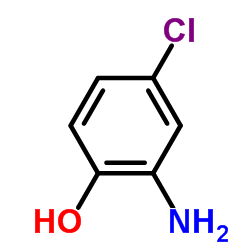2-Amino-4-chlorophenol

2-Amino-4-chlorophenol structure
|
Common Name | 2-Amino-4-chlorophenol | ||
|---|---|---|---|---|
| CAS Number | 3964-52-1 | Molecular Weight | 143.571 | |
| Density | 1.4±0.1 g/cm3 | Boiling Point | 276.8±25.0 °C at 760 mmHg | |
| Molecular Formula | C6H6ClNO | Melting Point | 150-153 °C(lit.) | |
| MSDS | Chinese USA | Flash Point | 121.2±23.2 °C | |
| Symbol |

GHS07 |
Signal Word | Warning | |
|
Rapid determination of aniline metabolites of chlorpropham in potatoes by micellar electrokinetic chromatography using negative-charged mixed micelles and laser-induced fluorescence detection.
Electrophoresis 26(15) , 2991-8, (2005) A rapid, reliable method has been developed for the multi-residue analysis of aniline metabolites of chlorpropham in potato samples. The method involves the precolumn derivatization of aniline metabolites with 5-(4,6-dichloro-s-triazin-2-ylamino) fluorescein ... |
|
|
Nephrotoxicity of 4-amino-2-chlorophenol and 2-amino-4-chlorophenol in the Fischer 344 rat.
Toxicology 110(1-3) , 47-58, (1996) Aminophenols and halogenated anilines induce nephrotoxicity and mild hepatotoxicity in rats. In this study, the in vivo and in vitro nephrotoxic potential of 4-amino-2-chlorophenol and 2-amino-4-chlorophenol, monochlorinated aminophenols and potential metabol... |
|
|
4-Amino-2-chlorophenol: Comparative in vitro nephrotoxicity and mechanisms of bioactivation.
Chem. Biol. Interact. 222C , 126-132, (2014) Chlorinated anilines are nephrotoxicants both in vivo and in vitro. The mechanism of chloroaniline nephrotoxicity may occur via more than one mechanism, but aminochlorophenol metabolites appear to contribute to the adverse in vivo effects. The purpose of this... |
|
|
Degradation products of a phenylurea herbicide, diuron: synthesis, ecotoxicity, and biotransformation.
Environ. Toxicol. Chem. 20(7) , 1381-89, (2001) The degradation products of diuron (photoproducts and metabolites), already described in the literature, were synthesized in order to carry out further investigations. Their ecotoxicity was determined using the standardized Microtox test, and most of the deri... |
|
|
Fluorescent materials for pH sensing and imaging based on novel 1,4-diketopyrrolo-[3,4-c] pyrrole dyes. Aigner D, et al.
J. Mater. Chem. C 1(36) , 5685-5693, (2013)
|
|
|
Synthesis and Characterization of Novel Processable and Flexible Polyimides Containing 3, 6-Di(4-carboxyphenyl) pyromellitic Dianhydride. Khosa MK, et al.
Adv. Chem. 2014 , (2014)
|